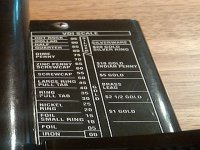Here is where metals will show up on your dial.
The way you figure out what you are digging before you dig it, which is never 100% by the way, is to "thumb" that disc knob and figure out where the metals in the range you see in the picture go away or "disc out".
*Tip*....It is more accurate to turn the knob way up and then turn it down slowly as you are swinging over the target and stop at the area where you hear a tone come in, than to turn it up until it fades out.
Now you have done this and lets say it was silent till you got to the zinc mark.
Now you have a clue, and this hobby is all about taking all your clues and putting them together to make an educated guess.
From studying the picture, you remember that this zinc area should sound off if you have a zinc penny or other zinc item, an Indian head penny, a screw-cap or gold.
Might be some other things like can slaw, but it could be one of the first four, too.
Maybe you want to switch to all metal, now, and run your coil around the target area and try to size the target.
Where does the tone sound loudest and then fade out?
Hit it from a different angle and try to get a picture in your mind on how big it is...coin size, maybe a little bigger?
In all metal or turning it back below zinc on the disc knob, how loud does it sound when you scan it?
Really loud, maybe medium loud or softer?
This gives you a clue on the depth.
Another depth trick is lift the coil and swing over it.
Do you lose it at 3 inches above the ground, 4-5?
If you know your limit of your detector, and subtract the height of your coil above the target where it goes silent, this can give you approximate depth.
Now you decide to whip your coil over the target real fast and see if the tones stay solid from all angles or breaks up.
If it breaks up it could be trash, if not, still might be a good target.
All of these techniques are aimed to give you clues, and those clues will lead you to an educated guess and that will lead you to digging a hole...or not.
As you put in your time, you also start to hear a slight differences in that tone.
A zinc penny might sound very solid and full and the same all the way through, but a screw-cap might not sound so full.
Maybe you noticed after locating and scanning hundreds of these that a screw-cap doesn't stay full, but maybe breaks a little right at the end.
It gets a little fuzzy.
You never could tell the difference at the beginning, but now, after much practice, you can hear that difference, and so you have another good clue as to what you might have sitting in the ground below you.
Solid tone, rings true, no breaking of the signal, small like a coin, really loud tone, can raise the coil pretty high before it fades out...I think this is a zinc penny that is about 1 inch down...then you dig it...and it is.
Or maybe not, like I said, not 100% in this hobby...ever...but you cut your odds down some on digging trash, and you made a good guess.
It's a process.
As you progress, your guesses get better.
The universe must be laughing at us that do this hobby because it made so many bad things ring up in the same areas as so many good things.
Aluminum hangs out where the high tone coins do.
Nickels and gold live in the same neighborhood as pull tabs...as a matter of fact, gold seems to live in almost all the neighborhoods.
Nobody is perfect, we all dig lots of trash, but the better you get the less trash you dig and the more treasure you find.
Study the picture, know your metals and where they line up in relation to your disc knob.
Then practice, practice practice.
Really listen and try to remember that tone you hear before you dig a target, then remember what target you dug after that specific tone.
It takes time for your instincts to kick in and this stuff becomes second nature, but it will eventually happen.
Once you dig enough holes.
That's how I do it.
HH





 Moving it to the "r" in iron gets rid of larger nails, bolts and the gold chains start to get a little fainter, although the teeny foil is still bothersome. Between "iron" and "foil" is where the tiny gold chains and teeny foil are no longer bothersome? and the larger foil and all other coins are still found and I feel is the perfect "coin" hunting setting because the gold rings down to tiny ones are easily found. If you aren't worried about the tiny stuff, I take a regular-sized piece of foil and set the disc to where the foil breaks up and this would be THE setting for coinshooters and the rings are still there-just some tiny ones may break up like the foil. Any higher than this is just flirting with disaster as far as gold is concerned. I HAVE set it to where tabs "crackle" and just hunted for all coins except the nickel in some horrendous places and had a ball-even brought back memories of the old days. To answer your last question: This is the order in which targets no longer give a signal as the discrimination is increased-and if I'm assuming you didn't know this, please forgive: iron, foil, nickel, pulltabs, coins above nickel. I no longer go above foil. Also, most Tesoros will not omit the higher coins at any setting.
Moving it to the "r" in iron gets rid of larger nails, bolts and the gold chains start to get a little fainter, although the teeny foil is still bothersome. Between "iron" and "foil" is where the tiny gold chains and teeny foil are no longer bothersome? and the larger foil and all other coins are still found and I feel is the perfect "coin" hunting setting because the gold rings down to tiny ones are easily found. If you aren't worried about the tiny stuff, I take a regular-sized piece of foil and set the disc to where the foil breaks up and this would be THE setting for coinshooters and the rings are still there-just some tiny ones may break up like the foil. Any higher than this is just flirting with disaster as far as gold is concerned. I HAVE set it to where tabs "crackle" and just hunted for all coins except the nickel in some horrendous places and had a ball-even brought back memories of the old days. To answer your last question: This is the order in which targets no longer give a signal as the discrimination is increased-and if I'm assuming you didn't know this, please forgive: iron, foil, nickel, pulltabs, coins above nickel. I no longer go above foil. Also, most Tesoros will not omit the higher coins at any setting.

